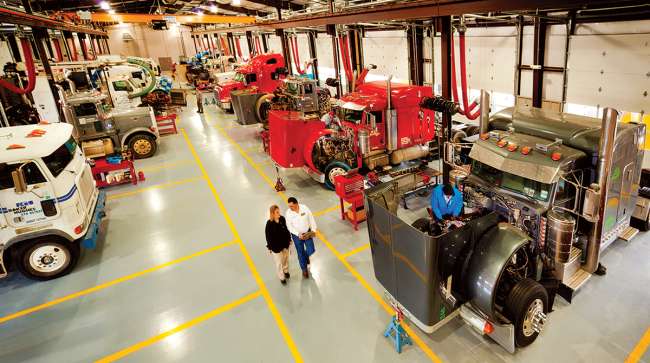Senior Reporter
Rush Records Lower Profit on Reduced Revenue

[Stay on top of transportation news: Get TTNews in your inbox.]
Truck dealership Rush Enterprises posted lower net income and revenue as it forecast a gradual recovery from the effects of the COVID-19 pandemic.
For the quarter ended Sept. 30, the San Antonio-based company reported net income of $33.9 million, or 60 cents per diluted share, on revenue of $1.2 billion. That compared with net income of $39.1 million, or 70 cents, on revenue of $1.6 billion a year earlier.
“We remain focused on monitoring COVID-19 and its effect on the economy and our industry, and we are cautiously optimistic that we are not only rightsized to support our customers but that the economic recovery, though gradual, will continue,” W.M. “Rusty” Rush, chairman and CEO of Rush Enterprises Inc., said during the earnings call.
He said the company’s strongest markets were in Arizona; California, especially from a parts and service perspective; and Florida thanks to construction and auto haulers. Truck orders in Ohio were good also.

Rush
The company’s new and used commercial vehicle sales reached $711 million compared with $1 billion in the 2019 quarter.
The company sold 2,584 new Class 8 trucks. That accounted for 5% of the new U.S. Class 8 truck market, based on industry quarterly sales of 52,161 that ACT Research reported.
In related news, Rush called Traton SE’s recently announced intention to acquire Navistar International Corp. great news as it will create global leverage for Navistar, whose International truck brand Rush sells.
READ MORE: Traton, Navistar Reach Agreement on $3.7 Billion Buyout
The transition to the “green wave” and new technology is going to happen, Rush said. “Sometimes I think it’s not going to be as fast as people say, but that transition will happen and that takes a lot of money.”
Meanwhile, Rush reported ACT currently estimates new U.S. Class 8 retail truck sales to be 220,900 in 2021, which represented an increase from its estimates of 171,400 in the second quarter and 162,800 in the first quarter.
The company sold 2,941 new Classes 4-7 medium-duty commercial vehicles, accounting for 4.8% of the U.S. total.
Used truck sales, with higher margins than typical, rose 10% year-over-year to 2,055 after earlier production shutdowns at the OEMs, strong freight demand and spot rates. Rush expects fourth-quarter sales to keep pace.
Parts and services revenue was $400.2 million compared with $454.7 million a year earlier.
Aftermarket products and services accounted for 66.8% of its total gross profits in the quarter, totaling $400.3 million, down 12% compared with the third quarter of 2019.
From a parts and service perspective, parts more than doubled the growth of service in the quarter, he said.
“Looking ahead, uncertainties remain about the pandemic and overall strength of the economy,” Rush said. “And the energy sector is still much slower than normal and likely will not improve significantly for some time. That said, though we expect some typical seasonal decline through the winter, we believe that the gradual recovery of the aftermarket business will continue.”

Over the past few episodes, we've had the chance to listen to the experiences of industry leaders and the strategies and planning that go into finding the right people for your workforce. Host Michael Freeze reviews the most important bullet points, from technician and driver training to incorporating diversity in recruitment and retention. Hear a snippet, above, and get the full program by going to RoadSigns.TTNews.com.
The company achieved a quarterly absorption ratio of 119.4% in the third quarter, compared with 120% a year earlier.
Rush calculates absorption ratio by dividing the gross profit from the parts, service and body shop departments by the overhead expenses of all of a dealership’s departments, except for the selling expenses of the new and used commercial vehicle departments and carrying costs of new and used commercial vehicle inventory.
In the quarter, Rush effected a stock split by distributing one additional share of stock for every two shares of Class A common stock and Class B common stock held by shareholders of record as of Sept. 28.
It also repurchased $2.7 million of its common stock, paid a cash dividend of $5.1 million and ended the quarter with $259.5 million in cash and cash equivalents.
The company owns and operates Rush Truck Centers, the largest network of commercial vehicle dealerships in the United States, with more than 100 locations in 22 states. It represents truck manufacturers Peterbilt, International, Hino, Isuzu, Ford and Mitsubishi.
Want more news? Listen to today's daily briefing:
Subscribe: Apple Podcasts | Spotify | Amazon Alexa | Google Assistant | More

